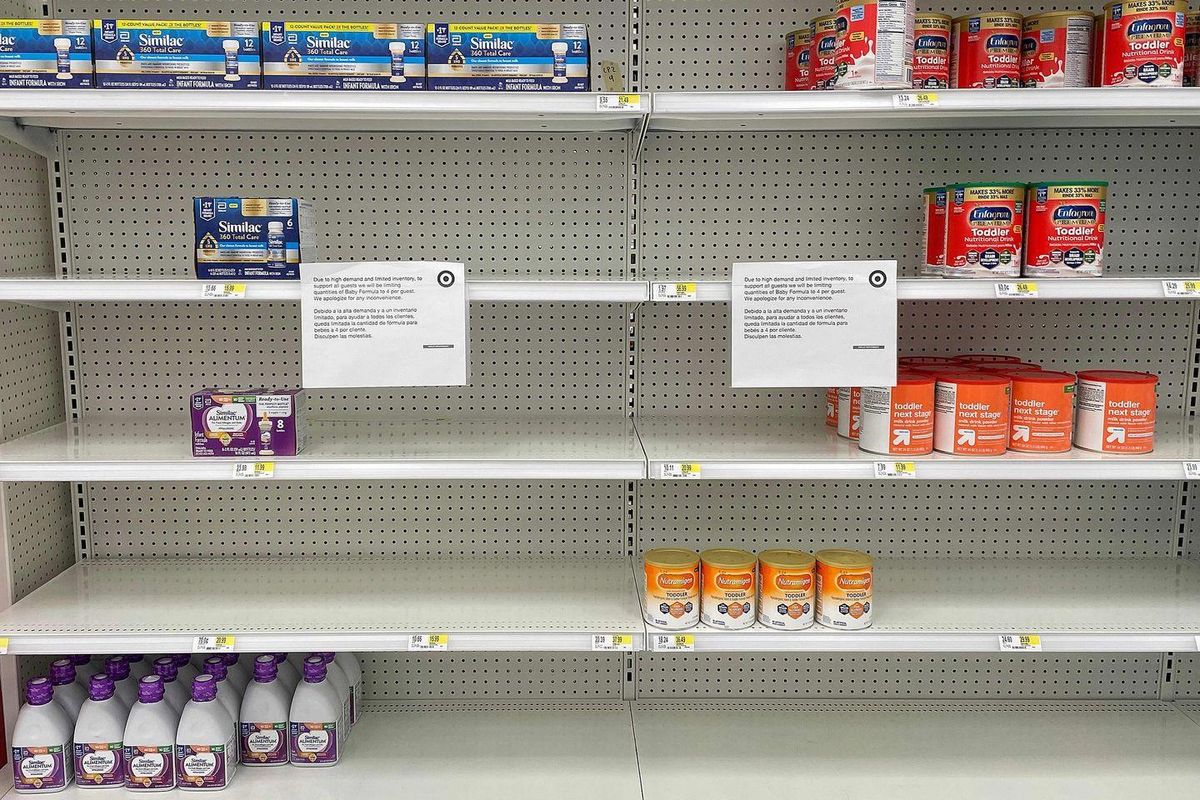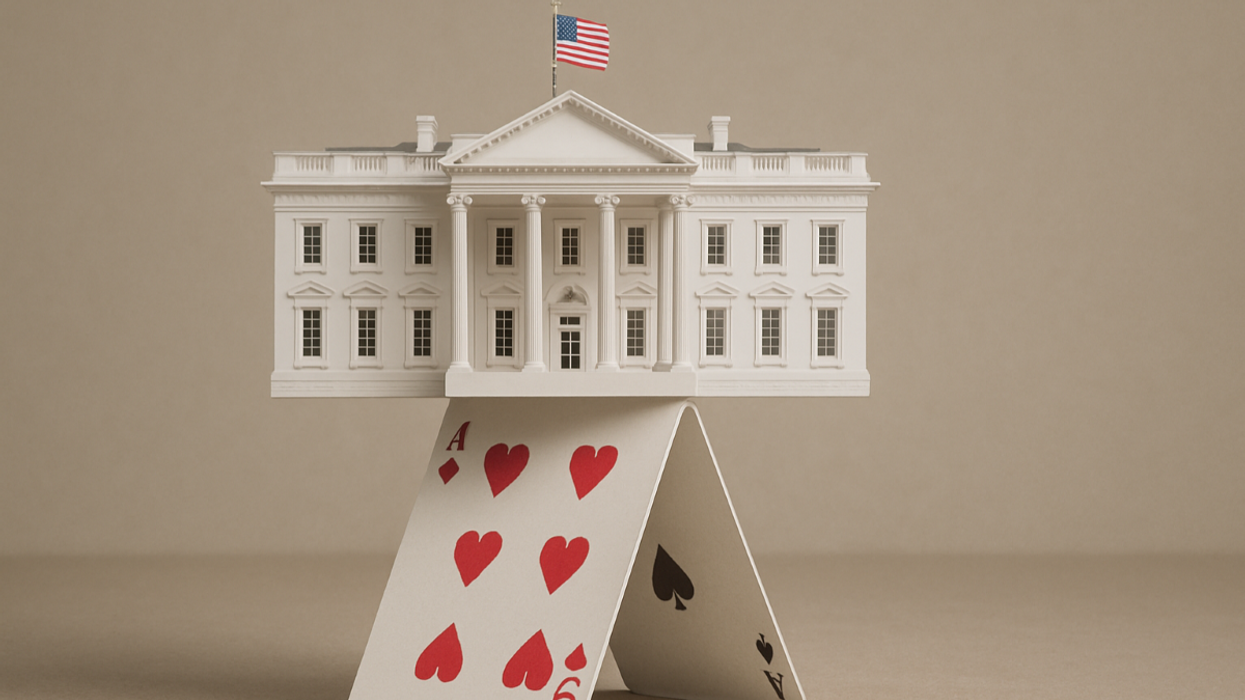Bare shelves. Hungry babies. Desperate parents.
The United States is experiencing a nationwide shortage of baby formula, threatening the health of millions of infants and giving an already-unpopular President Biden yet another headache ahead of November’s midterm elections.
According to Datasembly, 43% of formula in the country is currently out of stock—up from 30% in April and under 5% in the first half of 2021.
Three in four American babies six months and younger rely at least partially on formula for sustenance. Nearly 20% of infants receive formula within two days of being born. Children of low-income parents and people of color are disproportionately dependent on formula, as are babies with digestive disorders or specialized nutritional needs.
The worsening shortage has led worried parents to hoard what little formula they are able to find, exacerbating the crunch and prompting retailers to ration supplies by limiting purchases.
Want to understand the world a little better? Subscribe to GZERO Daily by Ian Bremmer for free and get new posts delivered to your inbox every week.
Not surprisingly given our extraordinarily polarized political environment, the episode has drawn comparisons to the bread lines and rationing the Soviet Union experienced just before its collapse. Republicans are blaming the Biden administration for both causing and failing to solve the shortage, conflating it with other consumer goods shortages, rising inflation, high gas prices, and the border crisis.
In reality, the challenges trace back to 2020, as Covid-19 strained global supply chains and disrupted virtually all industries and products—from lumber and coffee to toilet paper, gym equipment, and cars. Early in the pandemic parents rushed to stockpile formula, fearing shortages. Demand fell as they worked through their reserves, prompting suppliers to reduce production. By mid-2021, demand for formula had recovered, but producers were struggling to expand manufacturing capacity enough to keep up due to bottlenecks along every supply chain. As a result, the nationwide out-of-stock rate shot up from under 5% in the first half of 2021 to above 10% between August and December.
But the shortage didn’t begin in earnest until February 2022, when Abbott Nutrition—America’s largest formula manufacturer—issued a voluntary recall of certain formula products after suspected contamination in its Sturgis, Michigan plant was linked to the hospitalization of four infants, two of whom died. The U.S. Food and Drug Administration (FDA) ordered the Sturgis facility to shut down while it conducted an investigation, and the plant has remained closed ever since. While the FDA and Abbott agreed on May 16 to reopen the Michigan factory, parents will have to wait up to 2 months for formula to be back on shelves.
Bad policies to blame
The Abbott recalls and plant closure took a substantial chunk of the U.S. formula supply offline, at a time when the market was already stretched thin by pandemic-induced supply chain constraints. But product recalls happen all the time, and rarely do they cause national emergencies of this caliber.
Why did the recall of a single company’s products and the shutdown of a single factory cause the entire U.S. formula market to collapse?
Policy-induced market concentration. The U.S. government is the largest purchaser of infant formula in the country, accounting for about half of all sales in the country. It does so through WIC (formally known as USDA’s Special Supplemental Nutrition Program for Women, Infants, and Children), a federal welfare program that provides vouchers for low-income families to buy heavily subsidized food, including free formula. WIC feeds more than 1.2 million infants each year. The catch? In order to obtain discounted prices, WIC awards exclusivity contracts to a small number of approved formula manufacturers, and recipients are only able to use the benefit to buy designated types, sizes, and brands of formula.
This program design has resulted in a highly concentrated domestic industry, with nearly all formula sold in the U.S. produced by only three major companies: Abbott, Mead Johnson, and Gerber—the WIC suppliers. Abbott alone provides about half of the formula given to WIC recipients and about 40% of the total domestic supply. Before February, its Sturgis plant accounted for more than half of the company’s total formula production. It is no wonder, then, that the combination of recalls, the Sturgis closure, and the pandemic shock have managed to stretch the domestic industry even though all manufacturers are operating at full capacity.
Overzealous regulations. One way to increase the supply of formula at a time when domestic production can’t keep up with demand is to import more from overseas. However, the FDA’s regulation of infant formula is so nonsensically stringent that the vast majority of formula produced abroad is illegal to trade in the United States—not because it’s unsafe, but because it doesn’t meet the FDA’s onerous and often arbitrary labeling and nutritional requirements. In fact, the FDA bans the sale of formulas that have been approved by foreign regulatory agencies that the FDA itself rates as comparably capable. That includes most formulas from Europe, the largest global exporter of the product, even though studies have shown that they not only comply with FDA nutritional guidelines but also they are better than most American formulas because they don’t use corn syrup and have a higher share of lactose.
Gerald Butts, vice chairman of Eurasia Group and formerly Canadian Prime Minister Justin Trudeau’s chief political advisor, has argued that Big Dairy lobbying and regulatory capture are largely responsible for this state of affairs (though unclear if you can trust him: he’s Canadian).
The result? Only 2% of America’s formula supply is imported.
Protectionist policies. In addition to the FDA’s overly stringent requirements, which act as a non-tariff import barrier, U.S. trade policy explicitly restricts formula imports to shield domestic suppliers from competition. The U.S.-Mexico-Canada Agreement (USMCA), negotiated under President Trump to replace the North America Free Trade Agreement (NAFTA), imposes penalties on Canadian formula exports not just to the U.S. but to the whole world. What little foreign formula does manage to meet FDA requirements gets taxed at rates exceeding 17%, making it costly to expand the availability of formula when domestic production is stretched thin.
The current crisis is proof that trying to make everything at home can make the economy more vulnerable rather than more resilient, at the expense of American consumers. Contrary to politicians of both parties who rail against globalization and argue that “Made in America” equals “America First,” protectionist policies like tariffs, onshoring mandates, and federal procurement rules (“Buy American”) don’t make supply chains stronger. That’s not to say that unfettered, cost-minimizing offshoring is better. Economic security is all about design: geographic diversification, competition (both foreign and domestic), redundancies, and slack are all key to building flexible and resilient supply chains. But there is no inherent tradeoff between free trade and economic security, despite what the likes of Sen. Josh Hawley (R-Mo.) might claim.
The combination of high domestic market concentration, overzealous regulations, and protectionism induces artificial scarcity by depressing the supply of formula.
A product of special interest capture, economic nationalism, and well-intentioned but naïve policymaking, these long-standing bipartisan failures have made the U.S. formula market vulnerable to shocks like the Abbott recall and plant closure and the pandemic-induced supply snarls.
American babies are paying the price.
🔔 And if you haven't already, don't forget to subscribe to my free newsletter, GZERO Daily by Ian Bremmer, to get new posts delivered to your inbox.



















